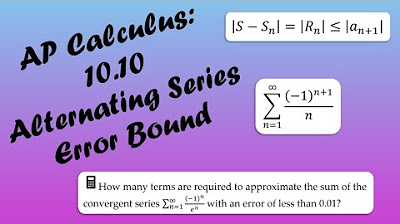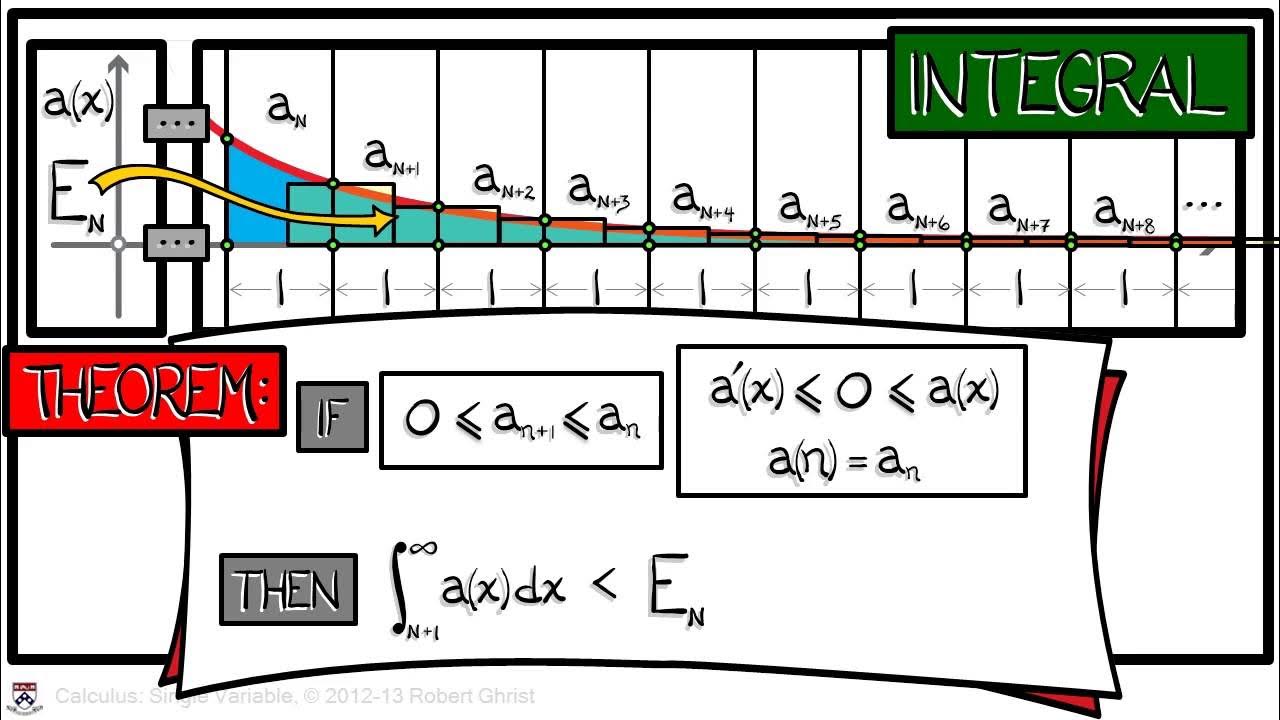Alternating Series Error Bound
TLDRThis educational video delves into the concept of alternating series error bounds, focusing on how to approximate values such as the natural logarithm of two using power series. It explains the process of determining if a series converges using the alternating series test and how to find the error in approximations. The video illustrates the error bound theorem, showing that the error is less than or equal to the absolute value of the next term in the series. It also provides examples and strategies for applying these concepts in AP Calculus, including multiple-choice and free-response questions, to solidify understanding.
Takeaways
- 📚 The video discusses the concept of 'error' in the context of alternating series and how it relates to the approximation of values like the natural log of two.
- 🔍 It explains the process of applying the alternating series test to determine if a series converges and whether it is absolutely or conditionally convergent.
- 📈 The script uses a visual approach to demonstrate how the partial sums of an alternating series converge to a specific value, using the natural log of two as an example.
- 📉 The concept of 'error' is illustrated through the difference between the partial sums and the actual value of the series, with the error decreasing as more terms are added.
- 📝 The video introduces the theorem for the alternating series error bound, which states that the absolute value of the difference between the series sum and a partial sum is no more than the absolute value of the next term.
- 🔢 The importance of verifying the convergence of a series before applying the error bound is emphasized, as it is a prerequisite for using the error bound.
- 📊 The script provides examples of how to calculate the error bound for a given series and how to interpret the results, including a multiple-choice question to test understanding.
- 🤔 The video encourages viewers to approach problems carefully, especially when determining the number of terms needed to achieve a specific error threshold.
- 📚 It also reviews recent pre-response problems from AP Calculus exams, showing how to apply the alternating series error bound in different scenarios.
- 📝 The video concludes with a reminder of the importance of understanding the alternating series test, absolute and conditional convergence, and the error bound for effective problem-solving in calculus.
- 👍 The presenter thanks the viewers for watching and encourages them to practice applying these concepts to become proficient.
Q & A
What is the main topic of the video?
-The main topic of the video is the investigation of alternating series, specifically focusing on the concept of the alternating series error bound.
What is an alternating series test?
-The alternating series test is a method used to determine if an alternating series converges. It checks if the absolute values of the terms of the series decrease and approach zero, and if the series is alternating.
How can we determine if a series is absolutely or conditionally convergent?
-We can determine if a series is absolutely or conditionally convergent by applying the alternating series test and other convergence tests, and by examining the behavior of the series' terms.
What is the natural log of 2 approximated by?
-The natural log of 2 is approximated by the alternating harmonic series, which is the sum of the series from 1 to infinity of (-1)^(n+1) * (1/n).
What is the concept of 'error' in the context of this video?
-In this context, 'error' refers to the difference between the approximated value of a series using a finite number of terms and the actual value that the series converges to.
What is the alternating series error bound theorem?
-The alternating series error bound theorem states that for an alternating series that converges to S, the absolute value of the difference between S and a partial sum is no more than the absolute value of the next term in the series.
How can we use the alternating series error bound in AP Calculus?
-In AP Calculus, the alternating series error bound can be used to estimate how close an approximation of a series is to the actual value by comparing it to the absolute value of the next term in the series.
What is the significance of the movement between the black points in the video?
-The movement between the black points signifies the change in the partial sum of the series, indicating how much the approximation changes with the addition of each term.
How does the error change as more terms are added to the series?
-As more terms are added to the series, the error generally decreases, getting closer to the actual value that the series converges to.
What is the strategy for determining how many terms are needed to achieve a specific error threshold?
-The strategy involves calculating the absolute value of the terms of the series sequentially until the term's absolute value is less than the desired error threshold, indicating that using that many terms will result in an error below the threshold.
Can you provide an example of how to apply the alternating series error bound to a problem?
-An example would be to use the first nine terms of the alternating harmonic series to approximate the natural log of 2. The error bound would be the absolute value of the tenth term, which is 1/10, indicating the approximation is within an error of 0.1.
Outlines
📚 Introduction to Alternating Series Error Bound
This paragraph introduces the concept of error in the context of alternating series. It discusses the ability to determine convergence and the type of convergence (absolute or conditional) using the alternating series test. The natural log of two is used as an example to illustrate how the series can be approximated by partial sums, and how the error of these approximations decreases as more terms are included. The paragraph emphasizes the importance of understanding the movement between partial sums and the true value, setting the stage for the discussion of the alternating series error bound.
🔍 Applying the Alternating Series Error Bound
The second paragraph delves into the application of the alternating series error bound. It uses the alternating harmonic series as an example to demonstrate how to calculate the error bound after approximating a series with a finite number of terms. The paragraph explains that the error is no more than the absolute value of the next term not included in the partial sum. It also addresses a multiple-choice question about determining the smallest number M that guarantees the error is less than M when using only three terms of the series, concluding with the correct answer of 1/19.
📉 Error Analysis and Series Convergence Verification
This paragraph focuses on the analysis of error in series approximation and the importance of verifying series convergence before applying the alternating series error bound. It provides a step-by-step explanation of how to determine the number of terms needed to achieve a specific error threshold, using the alternating series as an example. The paragraph also includes a discussion of a pre-response problem from 2022, which tests the understanding of the error bound in the context of a power series, and demonstrates the process of showing that the absolute value of the difference between the function evaluated at a certain point and its approximation is less than a given value.
📘 Examples and Conclusion on Alternating Series Error Bound
The final paragraph presents examples to further illustrate the application of the alternating series error bound, including a free-response problem that requires verification of series convergence and calculation of the error bound using the first two terms of a series. It emphasizes the need to verify the convergence of the series and to understand the decreasing magnitude of terms towards zero. The paragraph concludes with a summary of the key points discussed in the video, highlighting the importance of the alternating series test, absolute and conditional convergence, and the error bound in the study of calculus.
Mindmap
Keywords
💡Alternating Series
💡Error Bound
💡Convergence
💡Alternating Series Test
💡Partial Sums
💡Natural Logarithm
💡Power Series
💡Absolute Value
💡Free Response
💡AP Calculus
Highlights
Introduction to the concept of 'error' in the context of alternating series.
Explanation of how the alternating series test can determine convergence and absolute or conditional convergence of a series.
Demonstration of approximating the natural log of two using a power series.
Illustration of partial sums and their convergence to the natural log of two.
Introduction of the alternating series error bound theorem.
The error bound theorem states that the absolute value of the difference between the series sum and a partial sum is no more than the absolute value of the next term.
Verification of series convergence is necessary before applying the alternating series error bound.
Example of using the first nine terms of an alternating series to approximate a value and determine the error bound.
Explanation of how the error bound is determined by the absolute value of the term not included in the partial sum.
A multiple-choice question example involving determining the smallest number M for an error bound using three terms of a series.
Discussion on how many terms are needed to achieve an error less than one over 500.
Advice on being careful with calculations and not making off-by-one errors.
Example from a 2022 problem involving showing the absolute value difference between F of a half and a half is less than a 10.
Explanation of how to use the alternating series error bound in a free-response scenario.
Another example of using the first two terms of a series to approximate a function and determine an upper bound on the error.
Emphasis on verifying the convergence of the series before applying the alternating series error bound.
Final thoughts on the importance of breaking down complex topics into manageable chunks for better understanding and practice.
Transcripts
Browse More Related Video

AP Calculus BC Lesson 10.10

Alternating Series Day 2

Alternating series remainder | Series | AP Calculus BC | Khan Academy

Calculus BC – 10.10 Alternating Series Error Bound

Calculus Chapter 5 Lecture 56 Approximation & Error

Review of Lagrange Error Bound and Alternating Series Error for the BC Calculus Exam
5.0 / 5 (0 votes)
Thanks for rating: